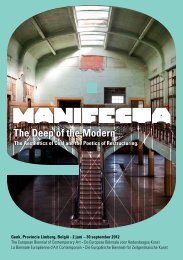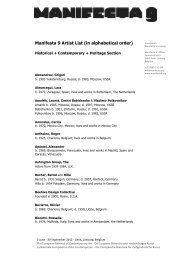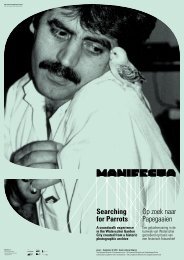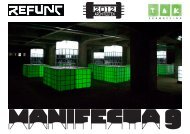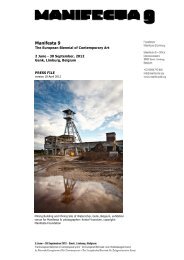informatie - Manifesta
informatie - Manifesta
informatie - Manifesta
Create successful ePaper yourself
Turn your PDF publications into a flip-book with our unique Google optimized e-Paper software.
12 Waterschei, Genk, Limburg (Belgium), June–September 2012 Waterschei, Genk, Limburg (Belgium), June–September 2012<br />
13<br />
Michaël Matthys, La Ville Rouge, 2005–2009 Aglaia Konrad, Bild 1A - “Die Frau als Schöpferin”, 2012 Installation view: Ana Torfs and Bea Schlingelhoff, Photo: Kristof Vrancken<br />
16. Michaël Matthys<br />
b. 1972, Charleroi, Belgium; lives and<br />
works in Charleroi<br />
geb. 1972, Charleroi, België; woont en<br />
werkt in Charleroi<br />
Moloch, 1998–2003. Installation with<br />
1000 aquatints (size A4) on 22 MDF<br />
panels (244 x 122 x 1.8 cm each) /<br />
Installatie met 1000 aquatints (A4<br />
formaat) op 22 MDF platen (244 x 122 x<br />
1,8 cm). Collection / Collectie: Musée des<br />
Beaux-Arts, Charleroi.<br />
La Ville Rouge (Charleroi City), 2005.<br />
Drawings with cow blood on polyester<br />
film, finished with polyurethane and resin.<br />
Fresco with 12 plates, 60 x 110 cm each<br />
/ Tekeningen met runderbloed afgewerkt<br />
met polyurethaan en resin. Fresco met 12<br />
panelen, elk 60 x 110 cm. Collection / collectie:<br />
La Banque Nationale de Belgique,<br />
Brussels.<br />
La Ville Rouge (planches originales),<br />
2005–2009. 76 drawings on paper with<br />
cow blood, finished with polyurethane and<br />
resin, 29.7 x 42 cm each / 76 tekeningen<br />
op papier met runderbloed, afgewerkt net<br />
polyurethaan en resin, elk 29,7 x 42 cm.<br />
Matthys documents the scars left by the<br />
demise of industrialism in Charleroi, paying<br />
homage to the metalworking industry<br />
and intimating the latent violence of social<br />
disenfranchisement with his peculiar<br />
choice of materials.<br />
Matthys documenteert de littekens die<br />
na het verdwijnen van de industrie in<br />
Charleroi zijn achtergebleven. Hij bewijst<br />
eer aan de metaalindustrie en duidt met<br />
zijn materiaalkeuze op het latente geweld<br />
als gevolg van de sociale rechteloosheid.<br />
Courtesy: Jacques Cerami Gallery, Charleroi. © the artist.<br />
15. Aglaia Konrad<br />
b. 1960, Salzburg, Austria; lives and<br />
works in Brussels, Belgium<br />
geb. 1960, Salzburg, Oostenrijk; woont en<br />
werkt in Brussel, België<br />
* PREFAB,<br />
Frankfurter Küche also stands for women<br />
in kitchens, but great chefs are men,<br />
2012. Installation, variable dimensions /<br />
installatie, variabele afmetingen.<br />
Konrad’s installation presents a set of<br />
comparative case studies that examine<br />
the conception, development and spatial<br />
organization of prefabricated housing<br />
and domestic life-space for the working<br />
classes.<br />
Met deze installatie presenteert Konrad<br />
een reeks vergelijkende casestudies<br />
waarin onderzoek wordt gedaan naar<br />
het denken over en de ontwikkeling en<br />
ruimtelijke ordening van geprefabriceerde<br />
huizen en woonruimtes voor de<br />
arbeidersklasse.<br />
Courtesy: Gallery Nadja Vilenne, Liège. Supported<br />
by: Austrian Federal Ministry for Education, Art and<br />
Culture. Acknowledgements: Katrin Kamrau, Asli Ciceka,<br />
Kris Kimpe, Willem Oorebeek, Margherita Spiluttini.<br />
Commissioned by <strong>Manifesta</strong> 9. © the artist, Margherita<br />
Spiluttini for the images of Margarete Schütte-Lihotzky.<br />
20. Nemanja Cvijanović<br />
b. 1972, Rijeka, Croatia; lives and works in Rijeka<br />
geb. 1972, Rijeka, Kroatië; woont en werkt in Rijeka<br />
17. Bea Schlingelhoff<br />
b. 1971, Waiblingen, Germany; lives and<br />
works in Zurich, Switzerland and New York<br />
City, USA<br />
geb. 1971, Waiblingen, Duitsland; woont<br />
en werkt in Zürich, Zwitserland en New<br />
York, VS<br />
I’m too Christian for art, 2012. Nine silk<br />
screen prints on paper, / Negen zeefdrukken<br />
op papier, 200 x 150 cm each / elk.<br />
Schlingelhoff brings revolutionary women<br />
like Simone Weil to the fore, resuscitating<br />
their dissident voices in a challenge<br />
to the current conservative outlook as<br />
well as to putatively radical ideologies.<br />
Schlingelhoff richt de aandacht op revolutionaire<br />
vrouwen zoals Simone Weil.<br />
Ze brengt hun dissidente stemmen weer<br />
tot leven en zet daarmee vraagtekens<br />
bij huidige conservatieve opvattingen,<br />
maar ook bij ideologieën die als radicaal<br />
worden gezien.<br />
Supported by: ifa Institut für Auslandsbeziehungen.<br />
Commissioned by <strong>Manifesta</strong> 9. © the artist.<br />
Nemanja Cvijanović, Monument to the Memory of the Idea of the Internationale, 2010–2012<br />
Monument to the Memory of the Idea of the Internationale, 2010, interactive sound<br />
installation / interactieve geluidsinstallatie.<br />
With The Monument Cvijanović draws public attention to the emotional content of political<br />
imperatives to demonstration, international worker solidarity, and the twentiethcentury<br />
dream of proletarian revolution.<br />
Met The Monument vestigt Cvijanović de publieke aandacht op de emotionele aspecten<br />
van de politieke verplichting om te demonstreren, van de internationale solidariteit<br />
van arbeiders, en van de twintigste-eeuwse droom van een proletarische revolutie.<br />
Supported by: Vidisquare. © the artist.<br />
18. Ana Torfs<br />
b. 1963, Mortsel, Belgium; lives and<br />
works in Brussels, Belgium<br />
geb. 1963, Mortsel, België; woont en<br />
werkt in Brussel, België<br />
[...] STAIN [...], 2012. Installation, 20<br />
framed inkjet prints with feathers and colored<br />
acrylic glass (53.5 x 53.5 cm each), 4<br />
display tables (93 x 68.5 x 327.5 cm each),<br />
2 loudspeakers on tripods, Bässgen media<br />
player, English voice, loop / installatie, 20<br />
ingelijste inktjet prints met ganzenveren<br />
en gekleurd acrylglas (53,5 x 53,5 cm elk),<br />
4 presentatietafels (93 x 68,5 x 327,5 cm<br />
elk), 2 luidsprekers op statief, Bässgen<br />
media player, klankband (Engels), loop.<br />
[…] STAIN […] is the result of an<br />
investigation into synthetic colors derived<br />
from coal tar. Torfs drew inspiration for<br />
the prints in the piece from a 1910 trade<br />
catalogue by Bayer’s Dye Factory.<br />
[…] STAIN […] is het resultaat van Torfs’<br />
onderzoek van synthetische kleuren die<br />
uit koolteer verkregen zijn. De afdrukken<br />
in deze installatie zijn geïnspireerd op<br />
een handelscatalogus van de Bayer verffabriek<br />
uit 1910.<br />
With the support of the Flemish authorities / Met de<br />
steun van de Vlaamse overheid. Acknowledgments:<br />
Jurgen Persijn, Christoph Van Damme, Dianne Weller.<br />
Commissioned by <strong>Manifesta</strong> 9. © the artist.<br />
Nicoline van Harskamp,<br />
Yours in Solidarity - first opening of the archive, 2011<br />
19. Nicoline van Harskamp<br />
b. 1975 Hazerswoude, The Netherlands;<br />
lives and works in Amsterdam, The<br />
Netherlands<br />
geb. 1975, Hazerswoude, Nederland;<br />
woont en werkt in Amsterdam,<br />
Nederland<br />
Yours in Solidarity, 2009–2012. Video,<br />
audio, archival material, variable dimensions<br />
/ video, audio, archiefmateriaal,<br />
variabele afmetingen.<br />
Nicoline van Harskamp uses the archived<br />
correspondence of Dutch anarchist Karl<br />
Max Kreuger to reconstruct the correspondents’<br />
life stories after the last date<br />
of writing, imagining what would happen<br />
if they were to meet today.<br />
Van Harskamp gebruikt de gearchiveerde<br />
correspondentie van de Nederlandse<br />
anarchist Karl Max Kreuger om het leven<br />
van de briefschrijvers na het einde van de<br />
correspondentie te reconstrueren, en stelt<br />
zich daarbij voor wat er zou gebeuren als<br />
ze elkaar nu zouden ontmoeten.<br />
Supported by: The Netherlands Film Fund, Mondriaan<br />
Fund, Amsterdam and <strong>Manifesta</strong> 9. Courtesy D+T Project,<br />
Brussels. © the artist.<br />
Ante Timmermans, Make a Molehill out of a Mountain (of Work), 2012 (detail), Photo: Kristof Vrancken<br />
21. Ante Timmermans<br />
b. 1976, Ninove, Belgium; lives and works in Ghent, Belgium<br />
geb. 1976, Ninove, België, woont en werkt in Gent, België<br />
Make a Molehill out of a Mountain (of Work), 2012. Site specific perfor(m)ative<br />
installation, variable dimensions / site-specifieke perfor(m)atieve installatie, variabele<br />
afmetingen.<br />
Part performance and part installation, Timmermans’s piece supplants the labor history<br />
of the Waterschei mine with the administrative task of perforating sheets of paper,<br />
leaving behind a molehill of confetti.<br />
Deels performance, deels installatie, vervangt dit werk van Timmermans de vroegere<br />
arbeid in de kolenmijn van Waterschei door kantoorwerk: het perforeren van vellen<br />
papier, waarbij een molshoop van confetti achterblijft.<br />
Met de steun van de Vlaamse overheid / with the support of the Flemish authorities, Pro Helvetia (Schweizer Kulturstiftung),<br />
Barbara Seiler Galerie, Zürich. Commissioned by <strong>Manifesta</strong> 9. © the artist.<br />
Tomaž Furlan, Wear Series, 2006–2012<br />
22. Tomaž Furlan<br />
b. 1978, Ljubljana, Slovenia; lives and<br />
works in Ljubljana and Škofja, Slovenia<br />
geb. 1978, Ljubljana, Slovenië; woont en<br />
werkt in Ljubljana en Škofja, Slovenië<br />
Wear Series, 2006–2012. Interactive<br />
sculptures with video / interactieve<br />
sculpturen en video’s.<br />
The “machines” in Furlan’s Wear Series<br />
satirize the dry and dumbfounding routines<br />
of the white-collar worker, poking<br />
fun at the assumption that exhausting,<br />
repetitive and alienating labor is a thing<br />
of the past.<br />
The ‘machines’ in Furlan’s Wear Serie<br />
zijn een satire op de saaie, afstompende<br />
dagelijkse sleur van de witteboordenwerker<br />
en steken de draak met de veronderstelling<br />
dat uitputtende, repetitieve en<br />
vervreemdende arbeid tot het verleden<br />
behoort.<br />
Supported by: Zavod P.A.R.A.S.I.T.E. Centre in Galerija P74.<br />
© the artist.<br />
Nicolas Kozakis & Raoul Vaneigem, Un moment<br />
d’éternité dans le passage du temps, 2012<br />
26. Nicolas Kozakis & Raoul Vaneigem<br />
Kozakis b. 1967, Liège, Belgium; lives and works in Brussels, Belgium. Vaneigem b.<br />
1934, Lessines, Belgium; lives and works in Vloesberg, Belgium<br />
Kozakis geb. 1967, Luik, België; woont en werkt in Brussel, België. Vaneigem geb.<br />
1934, Lessen, België; woont en werkt in Vloesberg, België<br />
Un moment d’éternité dans le passage du temps, 2012. Video/DVD, 5 min. 20 sec.<br />
Mikhail Karikis & Uriel Orlow, Sounds from Beneath,<br />
2010–11 Edward Burtynsky, China, Manufacturing #17, Deda<br />
Chicken Processing Plant, Dehui City, Jilin Province,<br />
23. Mikhail Karikis & Uriel Orlow<br />
Karikis b. 1975, Thessaloniki, Greece;<br />
lives and works in London, England.<br />
Orlow b. 1973, Zurich, Switzerland; lives<br />
and works in London<br />
Karikis geb. 1975, Thessaloniki,<br />
Griekenland; woont en werkt in Londen,<br />
Groot-Brittannië. Orlow geb. 1973, Zürich,<br />
Zwitserland; woont en werkt in Londen<br />
Sounds from Beneath, 2010–2011.<br />
Project by Karikis, video by Karikis &<br />
Orlow. Video/DVD, 7 min.<br />
Mikhail Karikis worked with a former coal<br />
miners’ choir from Snowdown Colliery in<br />
Kent (closed in 1987). He asked the group<br />
of retired miners to recall and vocalize<br />
the sounds of underground activity in the<br />
coalmines. The subsequent sound piece<br />
is sung by the miners and captured in the<br />
video created in collaboration with Uriel<br />
Orlow.<br />
Mikhail Karikis werkte met een koor dat<br />
bestaat uit ex-mijnwerkers van de steenkolenmijn<br />
bij Snowdown in Kent (Groot-<br />
Brittannië), die in 1987 werd gesloten.<br />
Hij vroeg de mannen de geluiden die te<br />
horen waren tijdens hun werkzaamheden<br />
in de mijn weer voor de geest te halen<br />
en deze met hun stem na te doen. Het<br />
vocale stuk dat zo ontstond werd door<br />
het koor gezongen en geregistreerd in<br />
de video die in samenwerking met Uriel<br />
Orlow werd gemaakt.<br />
Supported by: Arts Council England, the University of<br />
Westminster. © the artist.<br />
A lone construction worker builds a traditional stone house at an undisclosed location<br />
by the sea. His actions are accompanied by a text that argues for the need to reinvent a<br />
new, more humane vision of the world.<br />
Een eenzame bouwvakker werkt ergens bij de zee aan een traditioneel stenen huis. Zijn<br />
werkzaamheden gaan vergezeld van een tekst waarin wordt gezegd dat er een nieuwe,<br />
meer humane visie op de wereld moet worden uitgevonden.<br />
Supported by: Wallonia-Brussels Directorate of Culture, Department of Heritage and Visual Arts. Acknowledgments: Robert<br />
Dragot, Aniceto Exposito-Lopez, Andrée Blavier and Guy Jungblut, Marie-France Planeix, Éditions Yellow Now. © the artists.<br />
2005<br />
24. Edward Burtynsky<br />
b. 1955, St. Catharines, Ontario, Canada;<br />
lives and works in Toronto, Canada<br />
geb. 1955, St. Catharines, Ontario,<br />
Canada; woont en werkt in Toronto,<br />
Canada<br />
China: Manufacturing, 2005. Selection<br />
of eight photographs, variable dimensions<br />
/ selectie van acht foto’s, variabele<br />
afmetingen.<br />
Burtynsky’s photographs of shipyards,<br />
coal mines, steel mills, recycling plants,<br />
and large-scale urban development<br />
projects in China document both the<br />
processes and effects of industrial<br />
production.<br />
Burtynsky’s foto’s van scheepswerven,<br />
kolenmijnen, staalfabrieken, schrootterreinen<br />
en grootschalige stedelijke<br />
ontwikkelingsprojecten in China tonen<br />
zowel de processen als de gevolgen van<br />
industriële productie.<br />
Supported by: Galeria Toni Tàpies, Barcelona. Courtesy:<br />
Galeria Toni Tàpies, Barcelona, Nicholas Metivier Gallery,<br />
Toronto, Galerie Stefan Röpke, Köln. © the artist.<br />
Maryam Jafri, Avalon, 2011<br />
27. Maryam Jafri<br />
Lives and works in New York City, USA<br />
and Copenhagen, Denmark<br />
Woont en werkt in New York, VS en<br />
Kopenhagen, Denemarken<br />
Avalon, 2011. HD Video/DVD, 11 min.<br />
40 sec.<br />
Avalon examines the manufacture of<br />
fetish clothing and accessories for the<br />
sex industry. As Jafri’s previous work, this<br />
video straddles the boundary between<br />
cinema and theater, documentary and<br />
fiction.<br />
Avalon gaat over de fabricage van<br />
fetisjkleding en –accessoires voor de<br />
seksindustrie. Net als het eerdere werk<br />
van Jafri laveert deze video op de grens<br />
van film en theater, documentaire en<br />
fictie.<br />
Supported by: Picture This, Bristol, UK, Danish Arts Council<br />
Committee for Visual Arts, Danish Art Workshops. © the<br />
artist.<br />
Oswaldo Maciá, Martinete, 2011–2012<br />
25. Oswaldo Maciá<br />
b. 1960, Cartagena, Colombia; lives and<br />
works in London, England<br />
geb. 1960, Cartagena, Colombia; woont<br />
en werkt in Londen, Groot-Brittannië<br />
Martinete, 2011–2012. Auditory olfactory<br />
composition, variable dimensions /<br />
installatie met geluid en geur, variabele<br />
afmetingen.<br />
Maciá reanimates the defunct<br />
Waterschei mine with the sounds of five<br />
different anvils being struck by a variety<br />
of hammers, accompanied by an olfactory<br />
composition whose cool metal notes<br />
evoke “the smell of failure.”<br />
Maciá brengt de verlaten mijn van<br />
Waterschei weer tot leven met de<br />
geluiden van een groot aantal hamers die<br />
op vijf verschillende aambeelden slaan,<br />
daarbij vergezeld van een olfactorische<br />
compositie, waarvan de ‘noten’ van<br />
koel metaal een ‘geur van mislukking’<br />
oproepen.<br />
In collaboration with perfumer Ricardo Moya and Saul<br />
Giner Maciá for the music composition. Acknowledgment:<br />
International Flavors and Fragrances IFF. © the artist.<br />
Maarten Vanden Eynde, Plastic Reef, 2008–2012, Photo: Kristof Vrancken<br />
28. Maarten Vanden Eynde<br />
b. 1977, Leuven, Belgium; lives and works in Rotterdam, The Netherlands, Brussels,<br />
Belgium and Saint Mihiel, France<br />
geb. 1977, Leuven, België; woont en werkt in Rotterdam, Nederland, Brussel, België en<br />
Saint Mihiel, Frankrijk<br />
Plastic Reef, 2008–2012. Plastic debris, variable dimensions / gerecycleerd plastic,<br />
variabele afmetingen.<br />
Upon learning that there was a huge “floating landfill” made up of plastic trash<br />
swirling in the Pacific Ocean, Vanden Eynde collected hundreds of kilos of this refuse,<br />
which he then melted down to form Plastic Reef.<br />
Toen hij hoorde dat er een grote ‘drijvende stortplaats’ van plastic rommel ronddobberde<br />
over de Stille Oceaan, haalde Vanden Eynde honderden kilo’s van dat afvalmateriaal<br />
op en smolt het om tot Plastic Reef.<br />
replace with: With the support of the Flemish authorities / Met de steun van de Vlaamse overheid, the Mondrian Fund,<br />
Amsterdam, <strong>Manifesta</strong> 9, Genk. © the artist.




